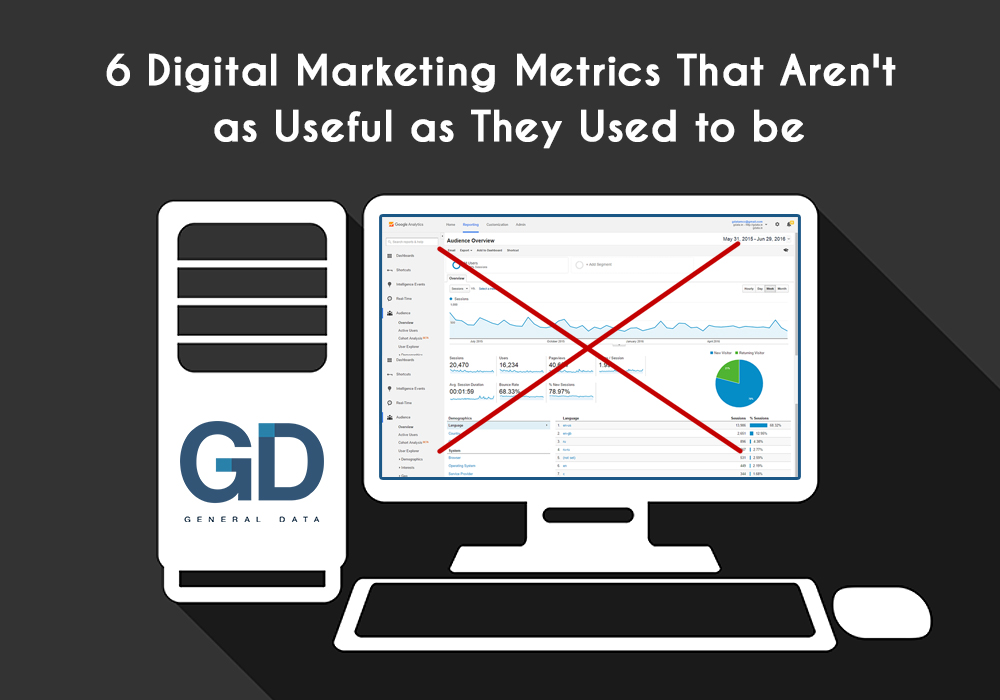“This is how it is supposed to be”, while a credible stance on many topics, doesn't really apply to Digital Marketing analytics & reports. Digital Marketing is still in a state of flux. As advertising & discovery platforms like Google Search, Google AdWords, Facebook Advertising change & evolve, metrics we rely upon also change, or get scrapped altogether.
These changes can be attributed to changes in the ways platforms like social networks, ad networks, affiliate networks etc. function, changes in security & user data retention policies, or simply because a newer metric has suddenly become accurately measurable and hence more reliable and effective.

Like fashion, even metrics are sometimes subject to trends & expiring shelf lives, here are a few metrics that aren’t as useful as many would have you believe:
1. Display Ad Impressions
Imagine a scenario where your ad is out there but you have no idea how many people actually saw it. With seemingly accurate Ad Impression statistics readily available, anybody would assume this simply doesn’t apply to online advertising. Unfortunately, it very much does, and to an alarming degree.
An Impression is registered if 50% of an ad’s pixels are in view on a screen for a minimum of one second – as defined by the Media Rating Council. As Google points out with this infographic, over 55% of Impression counts are in fact not actually viewed! And that’s an alarmingly high rate when you’re calculating RoI and campaign impact as an advertiser. This usually happens because the ad served is either ‘below the fold’, out of view, or because the ad loads in a background tab or popup.
Of course, in the absence of more accurate data, we still must take Impression metrics into consideration, but they must be discounted to a very high degree. So while this isn’t a ‘metric that needs to die’, it does have to be looked upon with weighted skepticism.
2. Anything to Do with Referred vs. Direct vs. Organic Segmented Traffic
Traffic source data has become increasingly unreliable. How much so? Luckily, Groupon did a study and shared their findings.
In their experiment, they saw that they lost 60% of their supposedly “direct” traffic when they deindexed their entire site for 6 hours.
This basically means 60% of their organic traffic was being classified as direct, rendering the reliance on traffic by source nearly irrelevant, since it simply was nowhere close to accurate.
This just goes to show how much SEO efforts can be disregarded by mistake. Looking at your Traffic Source data, you may feel SEO is irrelevant due to the high amount of direct traffic your site is receiving. In reality, most of that direct traffic is actually attributed to organic search engine results.
Segmentation reporting is downplaying SEO’s role your content marketing efforts. Avoid relying on it and you’ll find a much higher RoI than the data conveys.
3. Google Webmaster Tools Metrics
Google Webmaster Tools have a lot of important features, but when it comes to keyword metrics, you better think again.
The numbers are simply not accurate, with deviations in the 100s of percentage points.
Simply compare the numbers you see on Google Webmasters with Google Analytics & Google Adwords, you’ll find stark contrasts.
These numbers are only useful to identify trends and gauge scale, keep in mind that these metrics are just estimates and not actionable, accurate numbers.
4. Facebook Page Likes
A long time ago, you could create a Facebook page, get people to like it, and guarantee yourself spots on your followers’ News Feeds with your posts & updates. Quality content stood a great chance of organically going viral. This was correlated to the number of page likes you had to begin with.
Not anymore.
Under the pretext of clutter (higher volumes of content being generated), Facebook has become increasingly selective with the content it serves its users on their News Feeds. Unsurprisingly, this has meant that over time, sponsored (paid for) content has been gaining prominence. That's actually a bit of an understatement. Some reports & observations claim organic reach for business pages has been trending downwards so precariously that nowadays it lies somewhere close to 0! User engagement with organic content is less than 1% as well.
Of course, Page Likes still serves as a reliable indicator as to the maturity level of a page. Pages with likes in the millions will, in absolute terms, reach more people organically than pages with likes in the 100s or 1000s. But that really isn’t saying much considering how they have, for all practical purposes, been ‘phased out’ over time.
5. Keyword Rankings
Change is the only constant – This is a phrase which best suits this metric.
Various factors shoutingly suggest that Keyword rankings aren’t as accurate as data will have you believe. Factors like results personalization, changes in the search algorithm, geo-location are the main factors, among others.
6. PageRank
While PageRank was once considered reliable and accurate, it is no more so. Google themselves have slowly stop prioritizing their PageRank toolbar and by the time this post goes live, there’s a good chance it would have been abolished altogether.
With so many changes taking place in Online Advertising, its execution & measurement, and the fact that marketers keep trying to game these numbers and platforms keep having to adopt counter-measures, many metrics, especially the ones listed above, have become increasingly unreliable. As a marketer, it has become increasingly important to be discerning in your evaluation & study of traffic data.
Evolve as industry standards & reliable metrics change, else you’ll be trying, futilely, to optimize your marketing strategy based on faulty data.












